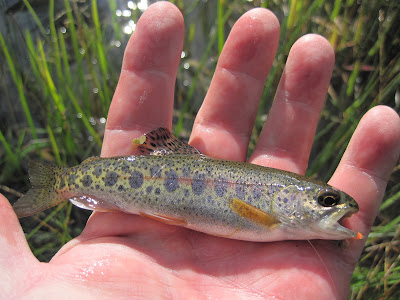Fall on the Upper Deschutes
As I mentioned in my last post about the Metolius River and Bend, OR, I also had an opportunity to fish the upper Deschutes River. One of the very cool things about this part of Oregon is that there are more fishable, accessible rivers than you can shake a stick (or flyrod) at.. But that didn't stop me from trying.
After some helpful directions and a hand drawn map from a local fly shop, we set out on a cloudy misty morning....
After a few stops and starts, we spied the fruits of our orienteering...
A convenient pull out was found...
After a few minutes (ok, 20 minutes) of rigging and getting into waders we were off. All fly fishers know that the amount of time required for rigging is directly proportional to the excitement of the day. It seems I can never tie a good knot in my tippet, find my wading belt, or get my boots laced correctly the first time on a new river; and the more so with a famous river. For me the same is true or the first trip of the season to a familiar river.
The pullout was next to a bridge, and we decided to fish upstream from there, since we had seen another fisherman head downstream; a decision we would later regret. Upstream most of the river included variations on this theme.
The water was out of its banks, due to an unusually deep snow pack last winter. Snow will begin to fly again in about a month in this area, and some of the old snow pack will remain.
The water was cold, and exceedingly clear. The river was mostly too deep to wade, so we were relegated to fishing from the banks. The river here is not wide, so I fished up one bank, Phil took the other. We had to be careful our casts didn't touch in the middle.
The main issue with fishing this section of the upper Deschutes was all of the dead-falls in the water and on the banks. Footing was treacherous. Slips and falls were pretty common for me. Banged up knees and shins were the price of admission. I was doing my best Dick Van Dyke impersonations all day long.
We were told at the fly shop that wooly buggers would do well here. However with so much wood in the water, I lost 2 lost buggers on successive casts, I changed to dry flies even though there were no significant hatches coming off...only occasional size 20 mayflies.
The fish, though small, were looking up. They hit flies placed in pockets around the fallen trees with abandon, Their colors were breathtaking.
After losing my smaller flies, I chose a larger , and was rewarded with this larger (about 12") fish.
After landing it, I was surprised that it took my fly. There wasn't much room in her mouth..
It looks like a small trout had been her main course...and my fly was desert...
Brook trout were plentiful and colorful..
Between the two of us, we probably landed in excess of 30 fish by lunchtime. We learned from a fellow at the pull out that the downstream path lead to large pools stacked with Brook trout as lard as 6 pounds ( he showed pictures of some he had taken). He also recommended that next time we come that we throw some big intruder style flies in a downstream and across drift with a sinking line to hook some of those beasts.On this river, he said, you only catch dinks with dry flies.
That is advice I will remember should I be fortunate enough to ply these waters again, And I pray I do.












Comments
This is during the sonefly hatch: http://fishkamp.com/?p=563 or http://fishkamp.com/?p=849
or summer steelhead on the swung dry fly: http://fishkamp.com/?p=978
And all summer you will find fish sipping caddis in back eddies in the morning and late at night in the Maupin area.